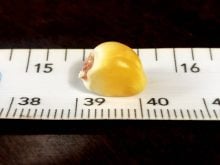Bt-resistant populations of European corn borer pose a significant risk to Canadian crop producers.
With multiple resistance uncovered, it’s possible Bt-based control technologies will cease to work for the problem pest, say extension staff at the Ontario Ministry of Agriculture, Food and Rural Affairs.
Older and more environmentally costly methods of pest control – including repeated in-season insecticide applications – might make a comeback as a result.
Read Also

Winter cereals beyond wheat gaining traction
Winter cereals such other than wheat, such as barley, could provide better yield and rotation options for Ontario growers.
Why it matters: European corn borer is a problem pest for many crops. If the Bt proteins used to control the pest become ineffective, farmers will have to return to the older, less economical and environmentally friendly control methods.
The European corn borer has more than 200 plant hosts, affecting a range of important commercial crops such as peppers, potatoes, wheat and corn, as well as other high value commodities like hops and cannabis. It has been largely controlled in field crops with Bt-based foliar sprays and Bt corn hybrids after the technology was introduced in 1996.
READ MORE: National group launches standardized corn borer scouting protocol
Tracey Baute, provincial field crop entomologist, considers the introduction of Bt corn hybrids a particularly significant success story – almost too successful. With the vast majority of corn acres regularly planted with Bt hybrids, Baute and others estimate that resistance to Bt proteins is developing quickly and could be as much as 90 per cent.
The first instance was identified in 2018, when a borer population in Nova Scotia was discovered to have resistance to Cry1F. Another population resistant to Cry1F was found in southern Quebec in 2019 and in Manitoba in 2020.
As Baute describes in a May 3 Field Crop News article, these instances show corn borer is becoming less susceptible to Cry1 proteins generally. This is concerning, since growers rely on four Cry proteins to control the pest, three of which are in the Cry1 category.
If corn borer can overcome one of them, writes Baute, it is much easier for it to become tolerant to the other Cry1’s too. The fourth (Cry2Ab2) must be paired with Cry1A.105 to be effective.
Cry1A.105 is the only remaining Cry1 protein effective against corn borer in Nova Scotia and resistance could happen quickly.
In an interview with Farmtario, Baute says the loss of Bt susceptibility will affect those who rely on foliar sprays as well as Bt genetics, and that corn borer damage also increases crop susceptibility to mycotoxins.
“The organic market relies on foliar Bt insecticides. We don’t know if they can be resistant to these foliar [sprays] but it is a real risk because that’s mainly their most effective and go-to tool for organic production,” she says.
“We took it for granted. We all did. Because Bt was so successful, we laxed on scouting as an industry. We relied on trust. But in general, growers aren’t going out to look for European corn borer. I’m not blaming them. It’s just the success of Bt. It would be unfortunate to lose that success.”
Mitigating risk
There are ways to reduce the risk of resistance development, as well as the growth in corn borer populations in general.
Shredding corn stalks with a flail mower after harvest is one of the best methods of prevention, says Baute. Doing so in autumn hits corn borers at the larval stage, preventing overwintering. This is even more important as the stalk strength of modern corn varieties makes a particularly good habitat for the pests.
“You need a flail mower to get low enough to the ground. Even at harvest, lower the combine a bit if you can. Tillage alone [won’t work]. You can’t just plow … but shredding and bury works. It’s what we had to do 100 years ago, according to the Corn Borer Act.”
Monitoring for activity and egg masses is critical, as is reporting findings to the provincial ag department.
“We need to work as a group. Now we’re working on how to take action more broadly. Even if you see egg masses, know that field needs to be looked at later,” Baute says.
“Have a frank conversation with sales staff and determine if – especially if it’s repeated use of the same hybrids and traits – if you want to target corn borer. And if you do, rotate those traits.”
Other ways to reduce risk include monitoring other host crops, planting hybrids with more than one corn borer-targeted Bt protein, and not using Bt corn hybrids where it is not a pest of concern.
“It’s a matter of finding where we can make ground on reducing risk, and salvage this technology if we can,” says Baute.
“It’s ironic that this pest has been here for more than 100 years, but I’ve learned over the years insects will avoid going extinct if they can.”















